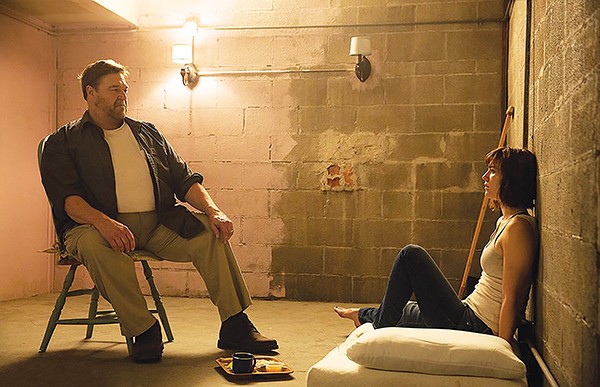One time-honored method to make movies on the cheap is the “bottle show.” The idea is simple. Building sets costs money, and location shots present their own logistical problems, so when you’re short on cash, just come up with a reason to keep all of your characters trapped in one place and watch the sparks fly as characters bounce off each other. In the world of ever-expanding movie budgets, where you can’t put on a cape and fight crime for less than $150 million, 10 Cloverfield Lane is a bracing blast of old-fashioned thrifty craftsmanship.
You can’t get any more bottle show than the “group of survivors trapped in a bomb shelter” scenario, and first-time director Dan Trachtenberg makes the most of it. His sense of economy is obvious in the opening shot, a languid track across a New Orleans apartment that establishes who Michelle (Mary Elizabeth Winstead) is: an aspiring fashion designer packing up to leave her boyfriend Ben (Bradley Cooper, who appears only as a voice on the phone). Her angry drive up I-55 is an homage to Janet Leigh’s escape with the stolen money in Psycho, complete with pounding, Bernard Herrmann-like score from Bear McCreary. But instead of stumbling into the Bates Motel, Michelle’s car runs—or is run—off the road, knocking her unconscious. When she wakes up, she’s chained to a bed in an anonymous basement, and the only door she can see looks suspiciously jail-like. She’s understandably alarmed, and meeting her new “host” doesn’t help. Howard (John Goodman) is a hulking Navy veteran who decided to build a survival bunker underneath his house sometime after his wife left him with their teenage daughter in tow. He tells Michelle that he rescued her from the car crash, but while she was unconscious, civilization collapsed, and they’re the only survivors.

John Goodman and Mary Elizabeth Winstead
This, naturally, raises a lot of questions, but there’s all the time in the world for answers. Howard’s not sure of the exact cause of the calamity—it could be nuclear or chemical, but whatever it is, the air outside is not fit to breathe, and nothing’s coming through on the radio. Howard’s story is more or less confirmed by the only other person in the bunker, Emmett (John Gallagher Jr.), a none-too-bright country boy who helped Howard build the bunker and thus knew where to go when the world went to hell. Holes in the story start to become apparent, and Howard’s giving off a real rapey vibe, even if he did save their lives, so Michelle has to decide if she’s in more danger in the bunker or facing the unknown on the surface.
Michelle and Howard’s characters are perfectly matched for confrontation: She runs at the first sign of trouble, while his instinct is to hide in situations he can control. Goodman puts on a powerhouse of a performance, vacillating back and forth between sympathetic and scary, often within the space of a sentence or two. Winstead, a horror movie veteran who has always risen to the challenges presented her, tops her former career best performance as Ramona Flowers in Scott Pilgrim vs. the World.
The efficient screenplay, credited to Josh Campbell, Matt Stuecken, and Damien Chazelle, started life as an unrelated script J.J. Abrams bought for his Bad Robot production company and was rebranded as a spiritual sequel to the 2008 found-footage monster movie Cloverfield. That may have been a stroke of genius on the part of Abrams. Even though 10 Cloverfield Lane is not a found-footage movie, and even at the end it is still unclear if its alleged apocalypse is related to New York’s giant monster issues from the first film, the two works share a philosophy of assuming the point of view of ordinary people caught up in giant, inconceivable disasters to posit that the monsters in our minds are more dangerous than the ones outside the bunker.